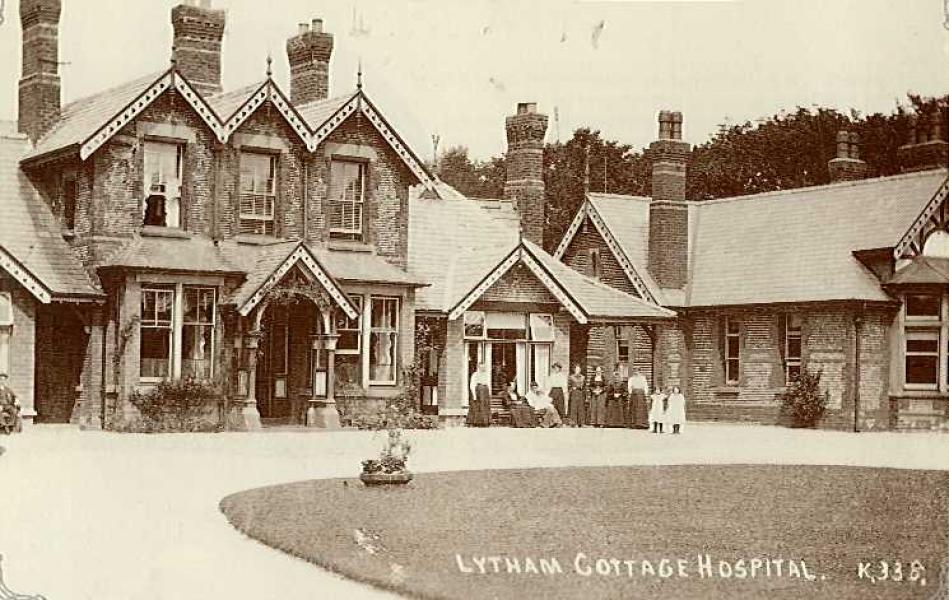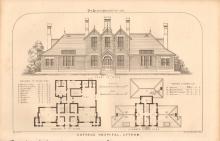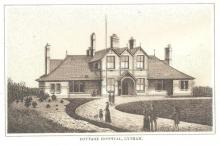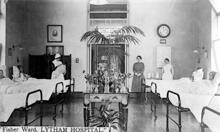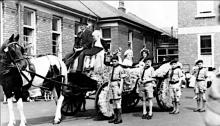LYTHAM HOSPITAL - THE FIRST IN THE FYLDE
Thursday August 3rd, 1871, was a red-letter day in Lytham. Shortly after 11 am a procession of about 50 gentleman formed in the Market Square and headed by the band of the 29th (Lytham) Rifle Volunteers, proceeded along Clifton Street for the official opening at noon of the new hospital - the first in the Fylde. The proposal for a hospital had been talked about for some years and the recent developments in anaesthetics and antiseptics were opening up new avenues in surgery. In 1870 there was an outbreak of low fever in Lytham which brought the proposal to a head and Colonel John Talbot Clifton, Squire of Lytham, undertook to give a site, put up a building and furnish it entirely at his own expense. The Foundation Stone of the hospital was laid on September 2nd 1870, by Mrs John Talbot Clifton.
The Lytham Cottage Hospital and Convalescent Home was erected for the purpose of relief to poor people in case of sickness and accidents’. It was a two-storey building of brick and cobbles and consisted of two ground-floor wards (one for male and one for female patients) each containing four beds. There were two upstairs wards so that the original bed complement appears to have been 16. The central part of the building on the ground floor contained a room for the Matron, a Committee Room, Surgery bathroom and wash-house. There was a mortuary in the yard and 'an operating room for cases of a severe nature’.
The County Architect, Mr Henry Littler, designed the building from a sketch made by Dr Holland of Prestwich Asylum. The total cost was £1,200. The members of the procession, having inspected the building, returned to the front entrance of the hospital where a platform has been erected and where Mrs Clifton now made her appearance to the cheers of the crowd. In handing over the completed building to the Committee, Mrs Clifton said:‘Ladies and Gentlemen, this building has been erected by Mr Clifton as a cottage hospital for the benefit of the Town and neighbourhood in order that relief and comfort may be obtained in cases of serious accident or illness, where such cases could not be so carefully attended to in the cottages of those who are unable to provide for sickness at home. In the name of Mr Clifton, who I regret has been unable to reach Lytham in time to meet you here today, I hand over this hospital to the town of Lytham and the Committee who have so kindly taken the responsibility of its management for the future. I hope that the hospital may prove a benefit to the town’.
The first Matron was Mrs St Clair (sometimes spelt Sinclair) described as ‘a lady of considerable experience, who for many years was one of the principal nurses at St Georges’ Hospital, London’. Dr Luke Fisher was appointed the first Medical Superintendent and Secretary of the hospital. The son of the Vicar of Heapey, near Chorley, Dr Fisher had qualified from Charing Cross Hospital Medical School in 1861 and taken his MD at St Andrews in 1862. Dr Fisher had been House Surgeon at the Preston Dispensary before being appointed to Lytham Hospital. Both the Medical Superintendent and the Matron proved to be outstandingly good appointments.
Under the Chairmanship of Mr J B Greenwood, a Committee of Management was formed consisting of Mr Edmundson, Mr T Fair, Dr Fisher, Mr Knowles, Mr B Rodway and Captain Whalley and the following Code of Rules was drawn up:-
CODE OF RULES
1. The Hospital is designed for the accommodation of the poor, when suffering from sickness or from accident.
2. The establishment shall consist of a regular nurse and another woman for the necessary work of the house.
3. Patients shall receive on the payment of a weekly sum (not being less than 6d. a day) the amount of which dependent on their circumstances, is to be fixed by the person recommending in conjunction with the manager of the hospital. Infectious cases and patients suffering from advanced pulmonary consumption, or who are unsound in mind, shall be ineligible for admission, unless with the special sanction of the committee.
4. Admission of the patients shall be granted by the manager, in consultation with the medical officer.
5. The medical department shall be under the control and superintendence of Luke Fisher, Esq., MD, but medical men who have attended their cases previous to their admission, may continue their treatment if they desire to do so.
6. Every requisite shall be provided in the hospital and patients may not receive food or drink from any source without the sanction of the medical officer.
7. The funds for the establishment and support of the hospital shall be raised by voluntary contributions and a statement of the receipts and expenditure shall be printed once a year and duly forwarded to each subscriber.
8. All subscriptions shall be payable yearly and in advance on the 1st July and any of the committee may receive donations and subscriptions, an account of which shall be rendered to the Treasurer.
9. The furniture and all other hospital property shall be invested in the Committee for the time being.
10. The Committee shall be entirely free from religious or political bias and the clergy and ministers of all denominations shall have free access to the hospital for the purpose of visiting any patient who may be members of their respective congregations.
Patients were admitted on the recommendation of an annual subscriber: 10/6d. per annum entitled the subscriber to one recommend each year and each extra half guinea conferred an additional recommend. Hospital fees were 6d per day for local patients and those from beyond a radius of 5 miles paid 12/6d per week. The charged included medical attendance, medicines and board and the Committee assumed that these fees would be sufficient to cover the running costs of the hospital.
Mr and Mrs Clifton’s interest did not end with the completion of the building. They made almost daily visits to the hospital and were always concerned for the care of the patients.
DEVELOPING TO SERVE A GROWING COMMUNITY
Dr Luke Fisher continued to be closely associated with the hospital until his death on January 30th, 1899 and his place in the affections of Lytham people was such that a public subscription was launched which raised £600. This money was used to build a new ward and to make a number of alterations. Fisher Ward was opened officially in September 1901 by Lady Drummond, a member of the Clifton family and a great personal friend of the late Doctor. Lady Drummond claimed that Dr Fisher had literally saved her life and from the tributes paid at the opening ceremony, it is evident that Dr Fisher was a remarkable man, utterly dedicated to the care of the sick and noted for his kindness to everyone. Contemporary accounts record the cases of an old women whose neighbours were afraid to go near her because she was ill with fever, ‘but Dr Fisher went every day and did everything that she needed’. In 1905 the first real operating theatre was erected by the late Mrs Forrest of Bodmin Ville, Lytham and furnished by the Rev. Canon Hawkins, Vicar of St Cuthbert’s, Lytham. By 1907 the hospital consisted of 25 beds.
In 1891 a new member had joined the Committee of Management - Mr Edward W Mellor of Fairlawn, Lytham. Born in 1852 at Bamford, near Rochdale, an accident in his early years caused life-long lameness and prevented him from going to public school, but his education by private tutors and at private schools produced a highly cultured man. He became a Governing Director of the business established by his father and uncle (Messrs J | Mellor, Worth Mills, near Bury) and he had extensive business interests. A man of long vision, Mr Mellor brought all his qualities and gifts to the service of the hospital. He became Chairman of the Committee in 1903 - an office he was to retain until 1930.
By 1920 it was becoming evident that the hospital was too small to serve the growing population. Mr Mellor decided “to widen the scope and service of the hospital, revise its construction, sweep away the old buildings and erect new ones”. The problems of keeping the services of the hospital running during re-building would be immense and they were to last for eight years. The architect, Mr Thomas Hedges of Lytham, drew up a plan of reconstruction and was singularly successful in allowing the hospital services to be maintained during re-building.
The first phase was completed in 1923 when Ashley Ward was opened, Sir Ernest Cassell, the banker, donated this ward in memory of his daughter, Mrs Maud Ashley, the wife of Colonel W W Ashley, MP for Blackpool from 1906-1918. Years later their daughter Edwina, better remembered as Lady Louis Mountbatten, was to visit Lytham Hospital to see the ward erected in memory of her mother.
The first X-ray department was opened in 1925. It was presented, complete with all its appliances by Mr and Mrs J L Lee of Woodfield, Lytham.
More construction was undertaken as further money was collected, but from time to time work had to be suspended for lack of funds. To encourage contributions, Mr and Mrs Mellor offered to give 30/- for every £1 raised and from May to December 1929 he contributed £1,700 in this way. The Foundation Stone of the new hospital was laid in October 1929 by Mr Mellor, who said: “It is my desire that the hospital shall be regarded as the hospital of Lytham people, for it is the outcome of a great effort on the part of the people of Lytham.’ In order that the rebuilding might be completed as speedily as possible, Mr Mellor presented the Committee with a cheque for £15,000. In the -Spring of 1930 the reconstruction was almost completed Mr Mellor died suddenly while on a visit to London on March 19th, 1930.
The original hospital with the pebble walls had been replaced by a fine structure of brick and Portland stone. To the medical staff, the provision of electric lighting must have been particularly welcome. Hitherto, the operating theatre - in common with the rest of the hospital - was lit by incandescent gas brackets and it was not unknown for the gas to fail. On one occasion this happened during an emergency operation late at night. The doctor had arrived in his chauffeur-driven Rolls Royce car and the chauffeur was instructed to head the car towards the operating theatre and to put the headlamps on at full. With this ‘emergency lighting’ the operation was successfully completed.
1930 - A SECOND OFFICIAL OPENING
For the second time in its history, the hospital had an official opening. This was performed on Saturday, October 4th 1930 by Lord Derby, the 17th Earl and the then Lord Lieutenant of Lancashire.
Mrs EW Mellor handed the key to Lord Derby, who declared the hospital open. He referred to the good work done by the hospital in the past and recalled that at the time of the 1871 opening his father was the MP for the area. ‘I always feel that a voluntary hospital gives more real personal sympathy than could ever come from a State or Municipal hospital and that sympathy is very efficacious in the care of patients’ said Lord Derby. In order that the re-built hospital might open free from debt Mrs Mellor gave a further £1500. to the Committee of Management of which she became President for life. The total cost of the re-building was in the region of £30,000.
With the enlarged hospital there were increased financial responsibilities. In 1931 the hospital’s income was £3,005 while expenses totalled £3,583 and the Committee could see the need for a children’s ward and for up-to-date X-ray equipment. In July 1931 the Committee of Management decided that the new X-ray equipment was essential and it was agreed to purchase ‘a modern shock-proof apparatus which would be capable of doing all the work required’ and to pay the cost of £1,592 by instalments. An X-ray appeal fund was set up and the Committee divided a street map of Lytham into squares, allocating to each member an area from which they were to be responsible for collecting weekly donations to the fund.
Through the enthusiasm of one of the members of the Committee of Management, the Revd.H G Rosher, a contributory scheme was started in 1930. An annual subscription of two guineas entitled the subscriber to free treatment and accommodation in the private wards, while a payment of twopence per week entitled the subscriber to similar benefits in the public wards. By September 1932 there were 67 subscribers in the first category and 1,035 in the second. The scheme terminated in 1947, when it was stated that the average annual income over the past few years had been £1,800 to £2,000.
Two more major developments were to take place before the commencement of World War II, imposed building restrictions. In 1933 a children’s ward was added and in 1939 the Private Block and Nurses Home was opened. A mortuary chapel was added in 1942.
RAISING MONEY FOR CARE
The Committee were ceaseless in their efforts to raise money and to improve the services of the Hospital, but it was all done with a deep concern for people. Sometimes there was difficulty in getting patients to pay their fees and the appointment of an official debt collector was considered, but every case of default was discussed and where real hardship was discovered, great leniency was exercised.
A Lytham Hospital Fete Committee was set up in 1920. It was responsible for the organisation of the Annual Gala Day in Lowther Gardens and over the years many thousands of pounds were raised for the support of the hospital through its efforts. There were Hospital Sundays, mannequin parades, swimming galas, ‘Cotton’ Balls, and Annual Hospital Ball held at the Majestic Hotel, bridge drive, organised by the doctors’ wives, a Cherrywood Pipe Club which met at the County Hotel, a 5.10 Club Carriage (presumably regular train travellers), bazaars and jumble sales, besides regular subscriptions.
The Committee of Management was to be responsible for one more major development. Extensions to the Maternity Department were opened on the 19th June, 1948, by Mrs Joseph Tweedale, a member of the Committee. By this time the hospital had a total or 53 beds.
1948 - ESTABLISHMENT OF THE NHS
On the Ist July, 1948 the Committee of Management met for the last time. After seventy-seven years of independent life ‘their hospital’ was about to be absorbed into the National Health Service. Would Lytham Hospital lose its character and identity, as it entered upon the third phase of its existence? Would the real personal sympathy, of which Lord Derby had spoken when he Consultant gynaecologist Dr FA Best with the hospital's opened the re-built hospital in new camera and theatre monitoring equipment October 1930, be lost in a central administration? What would happen to all the good-will which had supported the hospital from 1871 to 1948? These and many other questions must have been in the minds of the Committee members as they concluded their business.
The Committee of Management of Lytham Hospital, while accepting that they must relinquish control of ‘their hospital’, were deeply concerned that all the goodwill and support of Lytham people which had been the strength of the hospital in the past, should not be dissipated under nationalisation. Shortly before the Appointed Day, the Governors and Trustees of the hospital decided to form themselves into a group of ‘Friends of Lytham Hospital’ with the object of continuing their voluntary activities and interests. Thus at Lytham Hospital began what was to become a national movement. This first League of Hospital Friends in the country was a forerunner of many, till now there are nearly five hundred branches of the national Association of Leagues of Hospital Friends. Major J E Entwistle, MC a member of the Committee of Management since 1922, its Treasurer for about 15 years and its last Chairman, was the first President of “The Friends’ Mr H Craven the first Chairman and Mr J Robson Byers the first Secretary and Treasurer.
The objects of ‘The Friends’ are not limited to money-raising and they perform many voluntary services. The trolley service is perhaps unique in that there is no charge for the items offered: they are a gift to the patient. There are weekly visits to each patient, regular supplies of books and magazines, special Christmas gifts to patients in hospital at that time and emergency transport for relatives of patients. The National Health Service came into being on 5th July, 1948 and from that date the newly appointed Blackpool and Fylde Hospital Management Committee, as agent of the Manchester Regional Hospital Board, assumed responsibility for the day-to-day management and control of Lytham Hospital as part of the new Group.
Members of the Hospital Management Committee were determined to continue the policy of their predecessors and Lytham Hospital continues to operate for the benefit of Lytham residents, staffed by the General Practitioners of Lytham with an increasing number of consultant staff attending. With the ever-increasing number of attendances of Out Patients the facilities available became inadequate for the number of clinics required and in October 1960 a new Out Patient Department was opened by the Mayor of Lytham St Annes (Councillor N S Utley, JP). The erection and equipment of the new department cost £8,442 and was met from the Lytham Hospital Endowment Fund, thus continuing the benefits to the Hospital from past benefactors.
The Hospital Management Committee set itself very high standards of maintenance and many improvements were made between 1948 and 1974 when National Health Service reorganisation passed responsibility to the Blackpool Health District of the Lancashire Area Health Authority.
1980 - EXPANDING HOSPITAL SERVICES
A major development in the life of Lytham Hospital was the building of the Unit for the Elderly Mentally Ill, opened in 1980, consisting of two 28 bedded wards and a 30 place Day Hospital. The wards were named Talbot and Clifton after the Hospital's original benefactor. In 1992 the ground floor was adapted to replace inadequate facilities at Bath Street.
Sadly during 1986 the Maternity Ward was closed, despite a campaign by local groups to retain it. Falling birth rates and government reports led to the closure of many similar units throughout the country. However, following up-grading, the ward was re-opened as a 17 bed ortho-geriatric ward, and was named Sinclair in memory of the Hospital’s first matron. Several other building schemes and developments of existing facilities have kept Lytham Hospital at the forefront of the evolution of Community Hospitals. These developments have had substantial financial support from the Friends of Lytham Hospital.
- Alterations to Casualty 1980 - £8,000
- Day room provision 1978-1985 - £20,000
- Theatre upgrading 1989 - £42,000
- Extension to Out Patients 1990 - £115,000
Other schemes have included:-
Extension to Radiography Department 1989
Development of car parking facilities 1989
As well as structural changes the Friends also funded many items of medical and surgical equipment, including:- ;
- Physiotherapy equipment £10,000
- Ultrasound equipment for Xray £28,500
- Laparascopic surgical equipment £20,000
- In-patient services and equipment £40,000
- Donations to Victoria and Trinity Hospice £50,000
- In all since 1971, the Friends have
- donated over £530,000 to the hospital.
Medical staffing has expanded considerably and there are now 20 visiting consultant and 14 local General Practitioners involved with the Hospital. The Radiology and Physiotherapy Departments deal with both in-patient and out-patient investigations and treatments. Each year there are over 2,000 operations and over 25,000 out-patient attendances.
1994 - A HEALTHCARE TRUST
Responsibility for Lytham Hospital now rests with Blackpool, Wyre and Fylde Community Health Service NHS Trust.
Thus during a period that has seen the closure of many Community Hospitals, Lytham has continued to develop and prosper with major investments to provide modern health care facilities. With the emphasis on the shift to primary care, the increase in day-case surgery, and the provision of rehabilitation services available in the Community Hospital, close to GP surgeries, Lytham Hospital is well placed to continue to fulfil the function intended by its founders.
And so, Lytham Hospital has fulfilled and will continue to fulfil the function intended by its founders. Mr John Talbot Clifton wished it to be ‘for the benefit of the Town and neighbourhood in order that relief and comfort may be obtained’. Mrs John Talbot Clifton’s hope when she opened the hospital on the 3rd August 1871 ‘that the hospital may prove a benefit to the town’ has been achieved and her words are still relevant for the future.
CLOSURE
It was closed and demolished in 2007 to make way for the Primary Care Centre, housing local GPs and other NHS services.
If you have additional information or pictures that may usefully added to this page then please get in touch with us.
